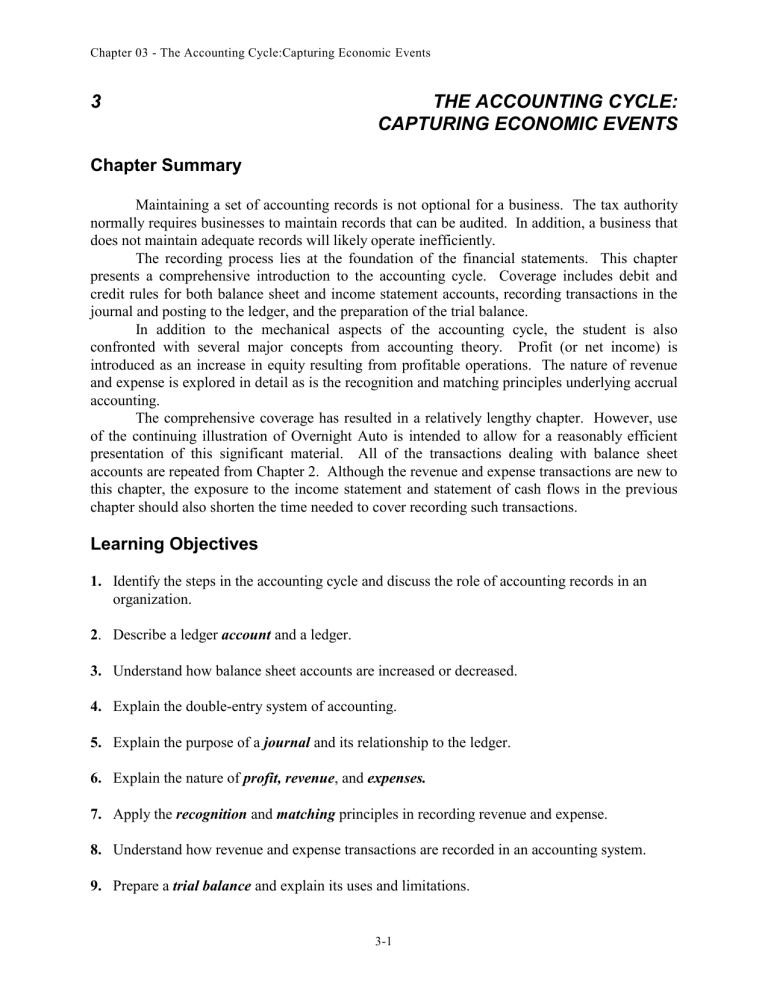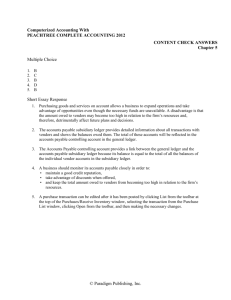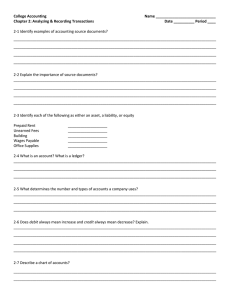
Chapter 03 - The Accounting Cycle:Capturing Economic Events 3 THE ACCOUNTING CYCLE: CAPTURING ECONOMIC EVENTS Chapter Summary Maintaining a set of accounting records is not optional for a business. The tax authority normally requires businesses to maintain records that can be audited. In addition, a business that does not maintain adequate records will likely operate inefficiently. The recording process lies at the foundation of the financial statements. This chapter presents a comprehensive introduction to the accounting cycle. Coverage includes debit and credit rules for both balance sheet and income statement accounts, recording transactions in the journal and posting to the ledger, and the preparation of the trial balance. In addition to the mechanical aspects of the accounting cycle, the student is also confronted with several major concepts from accounting theory. Profit (or net income) is introduced as an increase in equity resulting from profitable operations. The nature of revenue and expense is explored in detail as is the recognition and matching principles underlying accrual accounting. The comprehensive coverage has resulted in a relatively lengthy chapter. However, use of the continuing illustration of Overnight Auto is intended to allow for a reasonably efficient presentation of this significant material. All of the transactions dealing with balance sheet accounts are repeated from Chapter 2. Although the revenue and expense transactions are new to this chapter, the exposure to the income statement and statement of cash flows in the previous chapter should also shorten the time needed to cover recording such transactions. Learning Objectives 1. Identify the steps in the accounting cycle and discuss the role of accounting records in an organization. 2. Describe a ledger account and a ledger. 3. Understand how balance sheet accounts are increased or decreased. 4. Explain the double-entry system of accounting. 5. Explain the purpose of a journal and its relationship to the ledger. 6. Explain the nature of profit, revenue, and expenses. 7. Apply the recognition and matching principles in recording revenue and expense. 8. Understand how revenue and expense transactions are recorded in an accounting system. 9. Prepare a trial balance and explain its uses and limitations. 3-1 Chapter 03 - The Accounting Cycle:Capturing Economic Events 10. Distinguish between accounting cycle procedures and the knowledge of accounting. Brief topical outline A The accounting cycle 1 The role of accounting records B The ledger C The use of accounts D Debit and credit entries 1 Determining the balance of a T account 2 Debit balances in asset accounts 3 Credit balances in liability and equity accounts 4 Concise statement of the debit and credit rules 5 Double-entry accounting -- the equality of debits and credits E The journal 1 Posting journal entries to the ledger accounts (and how to "read" a journal entry) F Recording balance sheet transactions: an illustration (illustrated on pages 93-95) G Ledger accounts after posting (illustrated on page 97) H What is profit? 1 Retained earnings 2 The income statement: a preview a Income must be related to a specified period of time - see Case in Point (page 99) b Accounting periods 3 Revenue a The realization principle: when to record revenue 4 Expenses a The matching principle: when to record expenses b Expenditures benefiting more than one accounting period - see Case in Point (page 102) 5 The accrual basis of accounting 6 Debit and credit rules for revenue and expenses I Dividends J Recording income statement transactions (illustrated on pages 103 108) - see Your Turn (page 107) 1 The journal K February's ledger balances L The trial balance 1 Uses and limitations of the trial balance – see Ethics, Fraud & Corporate Governance (page 112) M Concluding remarks 1 The accounting cycle in perspective 3-2 Chapter 03 - The Accounting Cycle:Capturing Economic Events Topical coverage and suggested assignment Homework Assignment (To Be Completed Prior to Class) Class Meetings on Chapter Topical Outline Coverage Discussion Questions Brief Exercises Exercises Problems Critical Thinking Cases 1 2 3 A-D E-G H–M 1, 5, 8, 9 12, 13, 17,18 20 1, 3, 4 5, 6, 7 9, 10 1 2, 4, 7, 8,11 12 1, 2, 3 4, 5 1, 3 Comments and observations Teaching objectives for Chapter 3 Our objectives in presenting this chapter are to: 1 Establish the usefulness of accounting records in organizations. 2 Explain and illustrate the purpose, unit of organization, and format of ledger accounts. 3 Relate the rules for debiting and crediting balance sheet accounts to the “side” of the balance sheet on which the account appears. 4 Explain the double-entry system of accounting. 5 Explain and illustrate the purpose, unit of organization, and format of a general journal. 6 Explain the flow of financial information from the journal into the ledger accounts. 7 Explain the nature of profit, and define the terms revenue and expenses. 8 Illustrate the recording of revenue and expense transactions. Explain the debit and credit rules for these transactions in the context of the effects upon owner's equity. 9 Explain the realization principle and the matching principle, providing common examples. Contrast accrual accounting with cash flows. 3-3 Chapter 03 - The Accounting Cycle:Capturing Economic Events General comments Overnight Auto Service is used as a continuing example in Chapters 2 through 4. At the outset in Chapter 3, the activities of the company are limited to balance sheet transactions. This allows us to illustrate the mechanics of double-entry accounting and to show how changes in assets, liabilities, and equity are recorded in accounting records before discussing the more complicated concepts of revenue and expense. This approach also enables us to illustrate a very simple "accounting cycle" — the "flow" of information from the initial recording of transactions through the accounting records — without first having to cover adjusting entries and closing entries. Among the important concepts introduced in Chapter 3 is double-entry accounting. Although double-entry accounting and the related rules of debit and credit may sound procedural to some, we view the double-entry system as a truly ingenious device. Johann Goethe, the renowned eighteenth-century German poet and novelist, described this system as "one of the finest discoveries of the human intellect." The great power of double-entry accounting is its ability to record the components of profit and loss, that is, revenue and expenses, simultaneously with the related changes in assets and liabilities. Thus, any accounting system that develops an income statement as well as a balance sheet uses the principles of double entry. In the first class meeting on Chapter 3, we introduce students to the uses of accounting records in organizations. It is fairly obvious that accounting records will be used to record dayto-day transactions and serve as the basis for developing financial statements, tax returns, and other accounting reports. Less obvious to students are the other purposes of accounting records including internal control and performance evaluation. Discussion Question 1 can be used as the basis for class discussion of these uses of accounting information. We go on to introduce ledger accounts as a vehicle for illustrating double-entry accounting. We stress the relationship between the entry to record an increase in an account's balance and the "side" of the balance sheet upon which the account appears. This simple relationship is not only useful to students in learning the rules of debits and credits, but is the very device that makes the double-entry system work. In the first class meeting, we go on to introduce the general journal and focus upon the "flow" of information through the accounting records and into the financial statements (balance sheet). We stress the point that the journal and ledger contain the same information, differing only as to the unit of organization. The journal is organized by transaction, whereas the same data in the ledger is organized by financial statement item. (Some care should be taken to dispel the common misconception that "double entry" means recording the transaction in both the journal and the ledger.) Our next overall objective in Chapter 3 is to show how business profits are defined and measured in an accounting system. We emphasize the definitions of revenue and expenses, and the realization and matching principles. We find Exercise 7 useful in making the point that profit is a change in equity, not a change in assets. 3-4 Chapter 03 - The Accounting Cycle:Capturing Economic Events Careful attention should be given to both the realization principle and the matching principle. These principles represent the basic difference between accrual accounting and cash transactions. Also, these principles underlie many of the concepts that will be discussed in later chapters. We introduce these principles during the first class meeting but discuss them again in the second class meeting, illustrating the application of these principles in realistic business situations. Cases 1 and 2 are intended for this purpose. 3-5 Chapter 03 - The Accounting Cycle:Capturing Economic Events CHAPTER 3 NAME 10-MINUTE QUIZ A SECTION # Indicate the best answer for each question in the space provided. The account balances for Creative Band Limited as of May 31, 2009, are listed below in alphabetical order: Accounts Payable ....................... $12,000 Accounts Receivable .................. $14,000 Building....................................... $42,000 Cash ............................................ $8,000 Equipment ............................... Land......................................... Notes Payable ......................... Share capital ............................ $18,000 $52,000 $30,000 $92,000 On June 3, Creative Band, Inc collected $4,000 of its accounts receivable and paid $7,000 of its accounts payable. In addition, $2,000 of additional shares are issued for $5,600. 1 Refer to the above data. In a trial balance prepared on May 31, 2009, the sum of the debit column is: a $120,000. c $134,000. b $156,000. d Some other amount. 2 Refer to the above data. On June 4, the balance in the Cash account is: a $17,600. c $10,600. b $ 5,000. d Some other amount. 3 Refer to the above data. On June 4, the balance in the Share Capital account is: a $86,400. c $94,000. b $97,600. d Some other amount. 4 Refer to the above data. In a trial balance prepared on June 4, the sum of the credit column is: a $130,000. c $127,000 b $132,600. d Some other amount. 5 Refer to the above data. On June 6, the bookkeeper for Creative Band, Inc makes this entry: Equipment ..................................................................... 7,400 Cash ...................................................................... 4,200 Accounts Payable ................................................. 3,200 This transaction: a Decreases total assets . b Involves the sale of equipment for $7,400. c Increases total assets $7,400. d Increases liabilities . 3-6 Chapter 03 - The Accounting Cycle:Capturing Economic Events CHAPTER 3 NAME 10-MINUTE QUIZ B SECTION # Enter the following transactions in the two-column journal provided for Charlie’s Cabinetry. You may omit explanations. Mar. 2 4 5 Purchased auto cleaning supplies from Robert Suppliers for $750 on account. Collected an account receivable of $525 from a customer, Elegant Kitchens. Paid $275 in partial payment of an account payable to Lucy Co for equipment purchased in February. Issued shares in exchange for $5,600 cash. Purchased office equipment from Diamond’s Warehouse for $3,700; paid $1,700 cash and issued a note payable due in 90 days for the balance. 7 9 Date 20__ General Journal Mar 2 4 5 7 9 3-7 Chapter 03 - The Accounting Cycle:Capturing Economic Events CHAPTER 3 NAME # 10-MINUTE QUIZ C SECTION Capital Financial Advisors Limited had the following transactions during January, its first month of operations: a b c d e Issued to Marvin Tycoon 9,000 shares of share capital in exchange for his investment of $45,000 cash. Borrowed $30,000 from a bank and signed a note payable due in three months. Purchased office furniture costing $19,750; paid $6,000 cash and charged the balance on account. Paid $6,000 of the amount owed for office furniture. Issued an additional 2,000 shares to an individual who invests $10,000 in the business. Instructions Record the above transactions directly in the T accounts below. Identify each entry in a T account with the letter shown for the transaction. Cash Office Furnishings Accounts Payable Share capital 3-8 Notes Payable Chapter 03 - The Accounting Cycle:Capturing Economic Events CHAPTER 3 NAME 10-MINUTE QUIZ D SECTION # The following transactions occurred during June, the first month of operations for Accurate Manufacturing.: * * * * Issued 60,000 shares to the owners of the corporation in exchange for $600,000 cash. Purchased a piece of land for $250,000, making an $80,000 cash down payment and signing a note payable for the balance. Made a $100,000 cash payment on the note payable from the purchase of land. Purchased equipment on credit from National Supply for $40,000. 1 Refer to the above data. The balance in the Cash account at the end of June: a $52,000. c $420,000. b $350,000. d $380,000. 2 Refer to the above data. What are total assets of Precision Manufacturing at the end of June? a $710,000. c $630,000. b $890,000. d $460,000. 3 Refer to the above data. What is the total of Precision’s liabilities at the end of June? a $70,000. c $200,000. b $110,000. d $240,000. 4 Refer to the above data. What is the total equity at the end of June? a $60,000. c $240,000. b $110,000. d $600,000 3-9 Chapter 03 - The Accounting Cycle:Capturing Economic Events SOLUTIONS TO CHAPTER 3 10-MINUTE QUIZZES QUIZ A 1 C 2 C 3 B 4 B 5 D Learning Objective: 2, 3, 4, 9 QUIZ B Learning Objective: 2, 3, 4 Date General Journal 20__ Mar 2 Supplies 750 Accounts Payable 750 Bought supplies from Robert Suppliers. 4 Cash 525 Accounts Receivable 525 Collected from Elegant Kitchens 5 Accounts Payable 275 Cash 275 Partial payment on amount due to Lucy Co. 7 Cash 5,600 Share Capital 5,600 Issued share capital. 9 Office Equipment 3,700 Cash 1,700 Notes Payable 2,000 Purchased office equipment from Diamond’s Warehouse; note due in 90 days. 3-10 Chapter 03 - The Accounting Cycle:Capturing Economic Events QUIZ C Learning Objective: 2, 3. 4 Cash (a) 45,000 (c) (b) 30,000 (d) (e) (d) 6,000 6,000 (c) 10,000 Notes Payable (b) 30,000 Accounts Payable 6,000 (c) 13,750 Share Capital (a) 45,000 (e) 10,000 QUIZ D 1 C 2 A 3 B 4 D Learning Objective 2, 3, 4 3-11 Office Furnishings 19,750 Chapter 03 - The Accounting Cycle:Capturing Economic Events Assignment Guide to Chapter 3 Time estimate (in minutes) Difficulty rating Learning Objectives: 1. Identify the steps in the accounting cycle and discuss the role of accounting records in an organization. 2. Describe a ledger account and a ledger. 3. Understand how balance sheet accounts are increased or decreased. Brief Exercises 1-10 < 10 E Exercises 1 1 1, 15 1, 3, 6, 7, 15 1, 3, 6, 7, 9, 10, 11, 12, 13, 14, 15 2,4,5 4. 5. 6. 7. Explain the double-entry system of accounting. Explain the purpose of a journal and its relationship to the ledger. Explain the nature of profit, revenue, and expenses. Apply the recognition and matching principles in recording revenue and expenses. Understand how revenue and expense transactions are recorded in an accounting system. 9. Prepare a trial balance and explain its uses and limitations. 10. Distinguish between accounting cycle procedures and the knowledge of accounting. 2 1 – 15 < 15 E Problems 1 30 M 2 30 M 3 30 M 4 30 M 5 35 M Cases 6 50 S 7 60 S 1, 2 5, 6, 7, 8, 9, 10 1, 3, 6, 7, 8 1, 3, 6, 7, 10, 11, 12 1, 2, 5, 6, 7, 8, 9, 13, 14 3, 6, 7, 8, 9, 10 1, 2, 8, 9, 15 1 1, 5, 8, 10, 11, 12, 13, 14 1, 4, 10, 11, 12 1 1, 15 8. 3,4 3-12 8 60 S 1 15 M Net 2 30 S 3 30 M 4 10 E



